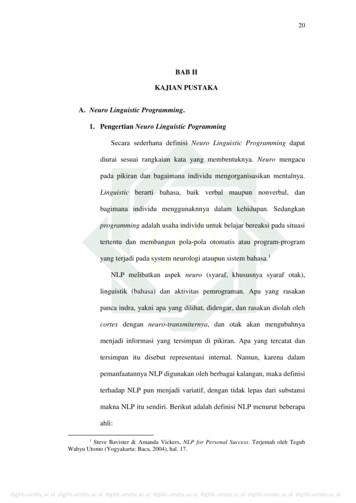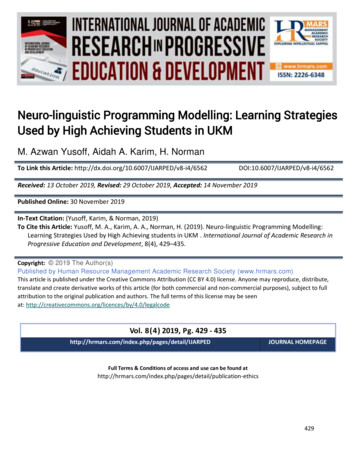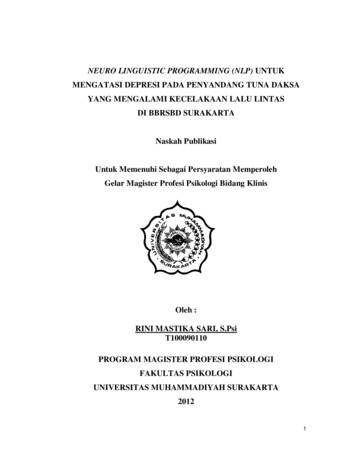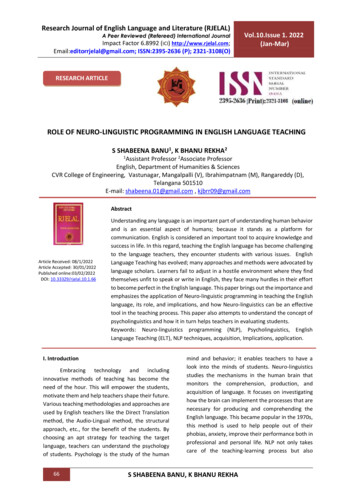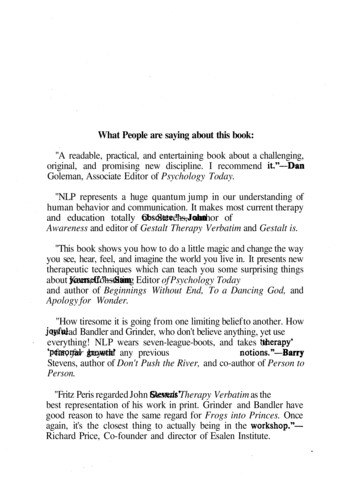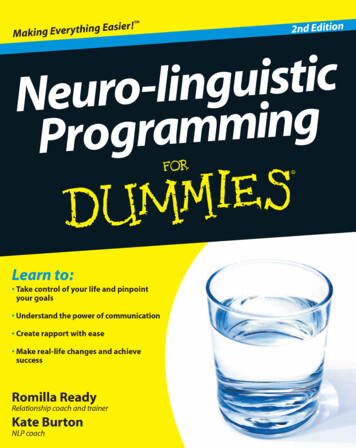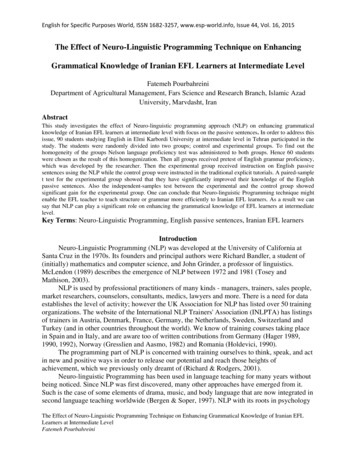
Transcription
English for Specific Purposes World, ISSN 1682-3257, www.esp-world.info, Issue 44, Vol. 16, 2015The Effect of Neuro-Linguistic Programming Technique on EnhancingGrammatical Knowledge of Iranian EFL Learners at Intermediate LevelFatemeh PourbahreiniDepartment of Agricultural Management, Fars Science and Research Branch, Islamic AzadUniversity, Marvdasht, IranAbstractThis study investigates the effect of Neuro-linguistic programming approach (NLP) on enhancing grammaticalknowledge of Iranian EFL learners at intermediate level with focus on the passive sentences. In order to address thisissue, 90 students studying English in Elmi Karbordi University at intermediate level in Tehran participated in thestudy. The students were randomly divided into two groups; control and experimental groups. To find out thehomogeneity of the groups Nelson language proficiency test was administered to both groups. Hence 60 studentswere chosen as the result of this homogenization. Then all groups received pretest of English grammar proficiency,which was developed by the researcher. Then the experimental group received instruction on English passivesentences using the NLP while the control group were instructed in the traditional explicit tutorials. A paired-samplet test for the experimental group showed that they have significantly improved their knowledge of the Englishpassive sentences. Also the independent-samples test between the experimental and the control group showedsignificant gain for the experimental group. One can conclude that Neuro-linguistic Programming technique mightenable the EFL teacher to teach structure or grammar more efficiently to Iranian EFL learners. As a result we cansay that NLP can play a significant role on enhancing the grammatical knowledge of EFL learners at intermediatelevel.Key Terms: Neuro-Linguistic Programming, English passive sentences, Iranian EFL learnersIntroductionNeuro-Linguistic Programming (NLP) was developed at the University of California atSanta Cruz in the 1970s. Its founders and principal authors were Richard Bandler, a student of(initially) mathematics and computer science, and John Grinder, a professor of linguistics.McLendon (1989) describes the emergence of NLP between 1972 and 1981 (Tosey andMathison, 2003).NLP is used by professional practitioners of many kinds - managers, trainers, sales people,market researchers, counselors, consultants, medics, lawyers and more. There is a need for dataestablishes the level of activity; however the UK Association for NLP has listed over 50 trainingorganizations. The website of the International NLP Trainers' Association (INLPTA) has listingsof trainers in Austria, Denmark, France, Germany, the Netherlands, Sweden, Switzerland andTurkey (and in other countries throughout the world). We know of training courses taking placein Spain and in Italy, and are aware too of written contributions from Germany (Hager 1989,1990, 1992), Norway (Gresslien and Aasmo, 1982) and Romania (Holdevici, 1990).The programming part of NLP is concerned with training ourselves to think, speak, and actin new and positive ways in order to release our potential and reach those heights ofachievement, which we previously only dreamt of (Richard & Rodgers, 2001).Neuro-linguistic Programming has been used in language teaching for many years withoutbeing noticed. Since NLP was first discovered, many other approaches have emerged from it.Such is the case of some elements of drama, music, and body language that are now integrated insecond language teaching worldwide (Bergen & Soper, 1997). NLP with its roots in psychologyThe Effect of Neuro-Linguistic Programming Technique on Enhancing Grammatical Knowledge of Iranian EFLLearners at Intermediate LevelFatemeh Pourbahreini
English for Specific Purposes World, ISSN 1682-3257, www.esp-world.info, Issue 44, Vol. 16, 2015is about the way the brain works and how the brain can be trained for the purpose of selfimprovement. It is also related to left-right brain functions, visual-auditory-kinesthetic learningstyles, multiple intelligences, and other areas of research that are attempting to identify not onlyteaching models, but optimum emotional learning states of an individual.Although very little research on Neuro-linguistic Programming in second languageteaching has been conducted, whatever has been accomplished suggests important assertions asto how NLP can make a difference in education, specifically in the acquisition of a secondlanguage (Lankton, 1979). This new technique explains how one processes information whichcomes to us from the outside world. Neuro-linguistic Programming is viewed as a generalapproach to life, including the study of acquisition of language. During the past ten years, thephilosophy has been influential to some degree in English as a second language as taught inEngland and in Europe in general (Frieden, 1981).Neuro-linguistic Programming is a collection of techniques, patterns, and strategies forassisting effective communication, personal growth, change, and learning (Blackerby, 1996).NLP was created in the early 1970s in Santa Cruz, California, when John Grinder, and AssistantProfessor of Linguistics and Richard Bandler, a psychology student at that time.As Tosey and Mathison (2003) mentioned, NLP would have the following characteristicsin relation of learning:The teacher- learner relationship is a cybernetic loop, a dynamic process in which meaningis constructed through reciprocal feedback; not a transmission of information from oneindividual to another, separate, individual.People act according to the way they understand and represent the world, not according tothe way the world ‘is’ (i.e. ‘the map is not the territory’).The prime interests in NLP are the ways in which people represent the world internally,through sensory imagery (principally visual, auditory and kinesthetic) and language. NLP isparticularly interested in the way internal representations are structured, both in themselves (e.g.the location, size, brightness etc. of visual imagery), and dynamically (e.g. as sequences). NLPassumes that the structure of internal representation shows regularities for, and is unique to, eachindividual.NLP also assumes that there are systematic relationships between this structuring and thatindividual's language and behavior. A learner's internal representations and processing arereflected, in various ways, in their language and their external behavior (e.g. non-verbalbehavior). (NLP courses train participants to observe and utilize these aspects).Skills, beliefs and behaviors are all learnt (e.g. skills have corresponding sequences ofinternal representation, often referred to as ‘strategies’). Learning is a process through whichsuch representations and sequences are acquired and modified.An individual's capacity to learn is influenced strongly by their neuro-physiological state'(e.g. a state of curiosity rather than a state of boredom), and by their beliefs about learning andabout themselves as learners (rather obviously, beliefs that one is capable of learning and thatlearning is worthwhile and fun are considered more useful than their opposites). Such states andbeliefs are also learnt and susceptible to change.Such modification happens through communication between teacher and learner, whichtakes place through verbal and non-verbal channels, both consciously and unconsciously. Thefunctioning of which human beings are conscious, and which can be controlled consciously,represents only a small proportion of total functioning.The Effect of Neuro-Linguistic Programming Technique on Enhancing Grammatical Knowledge of Iranian EFLLearners at Intermediate LevelFatemeh Pourbahreini
English for Specific Purposes World, ISSN 1682-3257, www.esp-world.info, Issue 44, Vol. 16, 2015All communication potentially influences leaning. Crucially, teachers' language andbehavior influence learners on at least two levels simultaneously; both their understanding of thetopic in question (e.g. the dynamic structure of their internal representations), and their beliefsabout the world, including learning.It follows that awareness of choice about one's own language patterns and behavior as ateacher, and sensitivity to and curiosity about their influence on and interaction with learner'sinternal representations, are crucial to effective teaching and learning.Since NLP is a theory of excellence, Bandler and Grinder (1982) started looking for thedifference that makes the difference between people who are excellent in their achievements andthose who have not yet achieved excellence. It involves discovering and then modeling (copingexactly) everything that 'excellent' people do. The ways they behave and the ways they perceiveand interpret the world.The purpose of this study is to investigate the effectiveness of Neuro-linguistic programingapproach on enhancing grammatical knowledge of Iranian EFL learners at intermediate levelwith emphasis on the passive sentences. The main question addressed in this study is: Doesteaching of English passive sentences using Neuro-linguistic Programming technique have anyeffect on enhancing EFL Learners' grammatical knowledge of such sentences at intermediatelevel?Literature ReviewSeveral educators have addressed the question of teaching techniques that would cooperatewith the students’ most highly valued channel (Swain (1985); Rinvolucri and Baker, 2006). Hill(1973, as cited in Bandler and Grinder, 1982) can be regarded as a pioneer in assessing the modeof behavior an individual uses when searching for meaning. He reported that the individual’sability to process information through sensory channels. He found that the most importantsensory channels are the visual, auditory and kinesthetic. Most adults are able to function in allthree modalities because of cognitive maturity.An exploratory study done by Jensen (1995) concluded that teachers also have preferencesand tend to teach according to their own personal styles, cognitive styles, learning preferencesand modality strengths. He pointed out that the learner may not have the same preferencesleading to the ineffectiveness of learning. Further, as Van Hoosier et al. (ibid) believes, assessingthe individual’s learning styles, modality strength, cognitive styles, and learning preferences canbe some useful guides to teaching actions.Visualization is a primordial factor within NLP. However, this decisive acquisition is usedvery little in formal education circumstance. Michel Grinder (1991) utilizes this technique in theeducational arena and bases his visualization activities on the Visual-Auditory-Kinestheticorganization within Neuro-linguistic plan. He continues to explain that this is the key forstudents to graduate from heights schooling and seek higher education. In other words, heindicates that the key to academic success of high school students depends upon their power tovisualize, which is, shuffling pictures with the mind’s eye.Research conducted by Eccles (1994) in Japan supported this thought. He discovered thatpeople who created pictures in their mind while indication a book had the least difficulty whenasked to remember the narration. He also found that it was easy to boost recall in other studentssimply by reminding them to visualize while reading. McCarthy (1991) claims that the largestpercentages of students are predominantly right-brained and that visual image problem isThe Effect of Neuro-Linguistic Programming Technique on Enhancing Grammatical Knowledge of Iranian EFLLearners at Intermediate LevelFatemeh Pourbahreini
English for Specific Purposes World, ISSN 1682-3257, www.esp-world.info, Issue 44, Vol. 16, 2015probably widespread. He finally proposes that this problem lies on the inability for students tosee content; therefore, it must be taught to them.Traditional ways such as Audio-lingual, Grammar Translation, Communicative LanguageTeaching, and Focus on Form made significant stocks to second language teaching and learning.They also gave birth to new and effective teaching strategies. Neuro-linguistic Programming(NLP) is one of those new approaches. It is a new technique that although not considered as ateaching approach, it is nowadays promising effective learning outcomes in the SLA field. Thedebate over the different teaching approaches in second language teaching has played a majorrole in the field of second language learning. For many linguists and researchers, this issue is stillnot fully resolved while new approaches have emerged throughout time.At the beginning of the 1970’s, involvement in teaching of English language became moreand more, geared toward cultural and social background. As a result, there has been a changefrom grammar translation and audio-linguistic scientist method acting to the research ofCommunicative Language Pedagogy (Savignon, 2001).Traditionally, grammar teachers emphasized that grammar translation was a very effectivemethod to learn a second language (Celce-Murcia, 1991). That is, learners just focused ongrammar drills and displacement from English to their indigene languages. Grammar translationwas the most popular method of foreign-language teaching in Europe and America from the midnineteenth to the mid-twentieth century (Richard-Amato, 1998). This method still exists in manycountries around the world. The purpose behind following this method of teaching for teacherswas to produce students who could read and write in the target language by teaching rules andapplications. Typical grammar-translation lessons were basically readings translated into the firstlanguage followed by the focus rule. Several sentences were juxtaposed to demonstrate how sucha rule worked. In this method, learners were expected to produce grammatical error-freetranslations and directions, and explanations were given in the first language. As a result of thismethod, oral communication in the target language was very little (Green, 1974).Audio- linguist was a new method that was based on behaviorism (Skinner, 2009). Itremains in the theory that language is acquired through the process of habit formation and thestimulus-response association. Audio-linguist was developed to replace or enhance grammartranslation.Investigators felt that students were not learning enough realistic whole language. They didnot know how to communicate using appropriate social language, gestures or expressions;therefore, they would fail to communicate pragmatic language. Interest in communicativeteaching styles was coined in the 1970s. Authentic language use in the classroom for meaningnegotiation through real communication engagement became very popular though manygrammatical errors were observed and in some instances fossilization would take place (Doughty& Williams, 1998).Focus on Form is an innovative teaching approach that promises to bridge the gap betweenGrammar-based and Communicative Language Teaching through the noticing of linguisticelements. Long (1996) indicates that focus on form draws students' attention to linguisticelements as they arise incidentally in lessons whose focus in on meaning or communication.Doughty & Williams (1998) see the performance of focus on form in communicativeteaching as an effective teaching method but it should not interrupt communication flow amongL2 students. Their findings show that it is possible to implement focus on form in content classessupported by feedback. Finally, Doughty and Varela mention that focus on form comprises a setThe Effect of Neuro-Linguistic Programming Technique on Enhancing Grammatical Knowledge of Iranian EFLLearners at Intermediate LevelFatemeh Pourbahreini
English for Specific Purposes World, ISSN 1682-3257, www.esp-world.info, Issue 44, Vol. 16, 2015of steps in which students participate in meaning before attention to linguistic features can beeffectively done.MethodParticipantsIn this study about 90 EFL students from Elmi Karbordi University at intermediate level inTehran were selected. At first the students were selected according to their mean scores ofprevious term of four classes at the university. So, their mean scores of last semester wereimportant in their selection. The students’ age was between 18 and 22; and the mean age was 20.But the gender of the participants was not considered in this study. For the researcher to makesure that the participants were at the same level of proficiency, Nelson proficiency test wereadministered to subjects. Then, based on the normal probability curve, those participants whosescores were between -1 and 1 SD were regarded as the main participants of this study. At lastthere were 60 students with a same level of English language proficiency. Finally, they wererandomly divided into two groups; control group and experimental group.InstrumentsIn this study the researcher utilized the following instruments. First, a 250A Nelsonlanguage proficiency test was administered to both groups, to select students from the same levelof knowledge. This test was administered to the participants as a standard measure to determinetheir level of proficiency for providing two groups in the research then all groups receivedpretest of English grammar proficiency, the third test was a post-test of proficiency in Englishgrammar, which was developed by the researcher.This test was developed according to the form of the test, the purpose of the test and thepopulation for whom it was intended. Therefore, there were not general questions. The grammarquestions were all at the intermediate level. Generally, the tests asked basic questions of Englishgrammar. These tests were developed through English grammar standards, so they could berepeatable over time and the scores were reliable.Nelson Proficiency TestA 50-item Nelson English Language Proficiency Test was used for ninety students. Thenaccording to this test, students' language proficiency and the scores they had got, they weredivided to two groups, first group was named "control group", second group was "experimentalgroup". This multiple-choice test comprised Nelson 250A proficiency test, which includesvocabulary, grammar, and reading comprehension items.In this test, about grammar, students were required to answer alternative-multiple choicequestions on any or all of the following: Grammar of the Simple Sentence, Grammar ofComplex-Compound Sentences, Idiomatic Usage (diction and structures), and WritingMechanics and Spelling. In the reading comprehension part students will be required to read fourpassages and to answer alternative-multiple choice questions on any or all of the following: Main&-or secondary ideas, Literal and figurative meaning, Explicit and implicit meaning, Writer’sprimary intention-attitude-tone, and Organizational structure (paragraph-text). There were twotypes of vocabulary items in this test. In the first type students were given a sentence followed byfour words or phrases. Students were to find the word or phrase that was closest in meaning toThe Effect of Neuro-Linguistic Programming Technique on Enhancing Grammatical Knowledge of Iranian EFLLearners at Intermediate LevelFatemeh Pourbahreini
English for Specific Purposes World, ISSN 1682-3257, www.esp-world.info, Issue 44, Vol. 16, 2015the underlined word (or words) in the sentence and that could be used in the sentence withoutchanging its meaning greatly. In the other type of item students were given a sentence with oneword omitted and a list of four words. Students should find the word which best completes thesentence.Homogeneity Process through Nelson Proficiency TestThe Nelson Proficiency Test was administered to 90 participants. Those students whoseNelson score fell within one standard deviation, 5.37, above and below the mean of 38.61 wereselected as homogeneous intermediate participants for this study. Hence 60 students whose scorewere between 34 and 43 were chosen.Pretest and Post-test of English GrammarTo collect data about the learners' grammatical knowledge, a test was administered. Thistest was developed by the researcher; the researcher used British Council online website todevelop her test. This test includes 30 multiple-choice questions focusing on checking theparticipants’ grammatical knowledge of using passive and active sentences in English. The testswere adopted from the book they were studying during the semester. The post-test was exactlythe pre-test and contained 30 multiple-choice questions focusing on checking the participants’grammatical knowledge of using passive and active sentences in English. Post-test was importantthan the pre-test for the experimental group. In these tests students should know where they haveto avoid passive voices and where they were allowed to use them. It was important for theparticipants to know where passive sentences were acceptable; they should follow these rules:the actor was unknown; the actor was irrelevant, the writer wants to be vague about who wasresponsible, the writer was talking about a general truth, and the writer wants to emphasize theperson or thing acted on.ProcedureThe following phases were accomplished in order to verify the hypothesis. First Nelsonlanguage proficiency test was administered to the subjects to find out the homogeneity of thegroups. However, in order to determine the reliability of the test, it was first piloted on 20students among the whole subjects; the scores and results showed that the test was a general oneand that it could be applied to the whole participants. Then, the test was applied to the mainparticipants. Those whose total score fall one standard deviation above and below the mean ofthe sample on the test were selected as the target samples. Finally, the selected participants wererandomly assigned into one experimental and one control group.In the next stage, the students in both groups were given a self-made and piloted grammarknowledge pretest, which tests the students’ familiarity with passive sentences in English. Thistest was developed by the researcher according to the grammar books the students studied. Then,the intervention program was used for experimental group through which grammar was taughtby using NLP activities.The teacher in experimental group used some strategies of NLP such as, VAK (Visual Auditory - Kinaesthetic) and anchoring. Visual learners are learners who work together in pairsand practice active and passive voice sentence. In this way, addressing visual learners wascombined with practicing grammar in an entertaining way.The Effect of Neuro-Linguistic Programming Technique on Enhancing Grammatical Knowledge of Iranian EFLLearners at Intermediate LevelFatemeh Pourbahreini
English for Specific Purposes World, ISSN 1682-3257, www.esp-world.info, Issue 44, Vol. 16, 2015In the same sense, the following auditory tool was applied for practicing and explainingpassive sentences: All the group members close their eyes and the teacher makes a noise, forexample, he-she might throw his-her book or tear a paper apart. The students were onlyconcentrating on the noise. When they open their eyes again, the teacher asked them “What wasthrown in our class?” and they had to answer using the passive sentence, e.g. “A book wasthrown in class”. Learners, however, needed to move and feel something to learn. For example,they could be asked to role-play a statue, or a tree or any other object.One student started and the other students joined to the role play one by one. When theyfinished their role-play, they sat down again and started talking about the exercise. One studentmight ask some questions about using passive sentences and the students should use thisstructure in their answers.Another exercise to practice the passive sentences that actually addressed all learner typeswas to role-play a machine. One student started making a certain movement and noise of amachine. Other students kept joining making different noises and different movements. Theother students watched them and talked about their colleagues’ activities: “What was written onthe board?” This exercise served the visuals– they can “see” what their colleagues were doing, aswell as the kinaesthetics– they can move and play, and the auditory learners– they can make anoise and “hear” which noise their partners were making.Thus, the teacher could invest more time in preparing other exercises that may be moretime consuming, for example the “re-teaching” exercises. The sense of re-teaching was thatkinaesthetic learners cannot fully follow the “teaching” process but might need “re-teaching”.The researcher would like to explain this technique by using an example of the passive sentencein the English language and asking questions with “what”: The trainer wrote the followingsentence on the blackboard:The letter was posted yeaterday.The attention of the learners was drawn to the use of “was” and “posted” in this sentence.An auditory reinforcement was given by explaining orally, a visual reinforcement by using color.The trainer explained what happened when this statement was transformed into a question.The trainer prepared different colorful cards for each word and punctuation mark andselected one student each word to hold the card.The students placed themselves in the correct word order and the learners can feel that“was posted” should be there. They had to move around to find the correct word order again.This kind of re-teaching helped the learners in their understanding of the correct formulation ofpassive sentences.Regarding the control group in this study, they were taught deductively as a 'top down'approach. It was said about top-down approach that it was essentially the breaking down of asystem to gain insight into its compositional sub-systems. In a top-down approach an overviewof the system was formulated, specifying but not detailing any first-level subsystems. Eachsubsystem was then refined in yet greater detail, sometimes in many additional subsystem levels,until the entire specification was reduced to base elements. A top-down model was oftenspecified with the assistance of "black boxes", these make it easier to manipulate. However,black boxes may fail to elucidate elementary mechanisms or be detailed enough to realisticallyvalidate the model. It breaks down from there into smaller segments (Hager, 1991).At the end of the course and treatments, the participants were given another grammar test,serving as the post-test. This test measured the participants’ grammar achievement in bothgroups through multiple-choice items.The Effect of Neuro-Linguistic Programming Technique on Enhancing Grammatical Knowledge of Iranian EFLLearners at Intermediate LevelFatemeh Pourbahreini
English for Specific Purposes World, ISSN 1682-3257, www.esp-world.info, Issue 44, Vol. 16, 2015Data AnalysisThe data in this study consists of three sets of scores which were obtained fromadministering three types of tests, a language proficiency test pilot group, and English grammarproficiency for both pretests and posttest. After collecting the data, the following procedure wasused to analyze the data: the mean and standard deviation of the participants’ scores estimated inorder to make a homogenized sample of the participants whose scores were one standarddeviation above and below the mean. The items of the test analyzed through item analysis andthe reliability of the test was estimated through K-21. In addition, in order to see whether therewas any significant difference between control and experimental group, after the treatments,independent and paired sample t-test was utilized for analyzing data.Results and DiscussionPre and Post testsThese tests include 30 multiple-choice questions focusing on checking the participants’grammatical knowledge of using passive and active sentences in English. The tests were adoptedfrom the book they are studying during the semester. To do so, first the descriptive statistics forparticipants’ performances on grammatical knowledge pretest in the two groups were calculated.Table 4.3. manifests the related descriptive statistics.Table 4.3. Descriptive Statistics for Control and experimental Groups’ grammaticalknowledge on As obvious in Table 4.3., the average mean score of control was 15.00 with the standarddeviation of 4.54; the mean score of experimental group turned out to be 14.35 with the standarddeviation of 4.96. The mean grammatical knowledge pretests of the two groups are not far fromeach other implying that they are at the same level of language proficiency.In order to compare the mean score of the control and experimental groups on grammarposttest were compared, first the participants’ performances on grammar posttest in the twogroups were assessed. The related descriptive statistics are demonstrated in Table 4.7 below.Table 4.4. Descriptive Statistics for Control and experimental Groups’ grammar 24.216Table 4.4. above illustrates that, the average mean score of control group was 24.70 withthe standard deviation of 5.10, on the other hand, but the average mean score of experimentalgroup was 32.75 with the standard deviation of 4.21. In fact, the mean grammar posttests of thetwo groups are far from each other even though the standard deviations of them are not verydifferent from each other.The Effect of Neuro-Linguistic Programming Technique on Enhancing Grammatical Knowledge of Iranian EFLLearners at Intermediate LevelFatemeh Pourbahreini
English for Specific Purposes World, ISSN 1682-3257, www.esp-world.info, Issue 44, Vol. 16, 2015The scores were calculated by t-test; according to Table 4.4., the results of paired sample ttest with a significant difference from pre-test of control group to post-test of control group, inwhich ‘t’ value is 2.491 and P- valu
Neuro-Linguistic Programming (NLP) was developed at the University of California at Santa Cruz in the 1970s. Its founders and principal authors were Richard Bandler, a student of (initially) mathematics and computer science, and John Grinder, a professor of linguistics. McLendon (1989) describes the emergence of NLP between 1972 and 1981 (Tosey and
